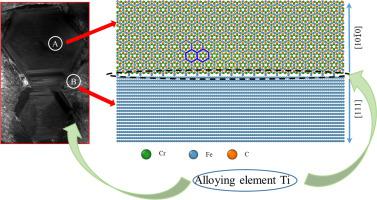Materials & Design ( IF 7.6 ) Pub Date : 2021-09-28 , DOI: 10.1016/j.matdes.2021.110133 Wei Shao 1 , Yefei Zhou 2 , Lei Zhou 1 , Lixiang Rao 1 , Xiaolei Xing 2 , Zhijun Shi 3 , Qingxiang Yang 1

|
Alloying element Ti plays an important role in improving the mechanical properties of hypereutectic Fe Cr
Cr C hardfacing coating, but its peeling resistance have been neglected. Here, the hardness and wear rate of the hypereutectic Fe
C hardfacing coating, but its peeling resistance have been neglected. Here, the hardness and wear rate of the hypereutectic Fe Cr
Cr C and Fe
C and Fe Cr
Cr C
C Ti hardfacing coatings were measured. The crystal structure and orientation relationship of primary M7C3 carbide and eutectic austenite matrix were confirmed. Then, the interface properties of γ-Fe//M7C3(Ti) interface were calculated by first principles. The results show that the micro-Vickers and macroscopic Rockwell hardness of the Fe
Ti hardfacing coatings were measured. The crystal structure and orientation relationship of primary M7C3 carbide and eutectic austenite matrix were confirmed. Then, the interface properties of γ-Fe//M7C3(Ti) interface were calculated by first principles. The results show that the micro-Vickers and macroscopic Rockwell hardness of the Fe Cr
Cr C
C Ti hardfacing coating are increased, and its wear rate is decreased from (4.33 ± 0.333) × 10−6 mm3/Nm to (3.64 ± 0.366) × 10−6 mm3/Nm. The Ti-doping can effectively inhibit the initiation and propagation of cracks and improve the peeling resistance of M7C3 carbide. Meanwhile, the orientation relationship of eutectic austenite/primary M7C3 carbide is γ-Fe(1 1 1)//(Cr, Fe)7C3(100). Among C
Ti hardfacing coating are increased, and its wear rate is decreased from (4.33 ± 0.333) × 10−6 mm3/Nm to (3.64 ± 0.366) × 10−6 mm3/Nm. The Ti-doping can effectively inhibit the initiation and propagation of cracks and improve the peeling resistance of M7C3 carbide. Meanwhile, the orientation relationship of eutectic austenite/primary M7C3 carbide is γ-Fe(1 1 1)//(Cr, Fe)7C3(100). Among C Fe1, Cr
Fe1, Cr Fe1 and Fe
Fe1 and Fe Fe1 interfaces, interface energy of Fe
Fe1 interfaces, interface energy of Fe Fe1 model is the smallest (1.954 J/m2), and its adhesion work (Wad) is the largest (0.756 J/m2). Moreover, Wad of Ti-doped interface (4.123 J/m2) is larger than that of Fe
Fe1 model is the smallest (1.954 J/m2), and its adhesion work (Wad) is the largest (0.756 J/m2). Moreover, Wad of Ti-doped interface (4.123 J/m2) is larger than that of Fe Fe1 one (3.045 J/m2) after relaxed, which indicates Ti-doping is beneficial to enhance adhesive strength between γ-Fe//M7C3 interfaces, which improves the peeling resistance of M7C3 carbide.
Fe1 one (3.045 J/m2) after relaxed, which indicates Ti-doping is beneficial to enhance adhesive strength between γ-Fe//M7C3 interfaces, which improves the peeling resistance of M7C3 carbide.
中文翻译:

Ti掺杂对过共晶FeCrC堆焊层初生M7C3碳化物抗剥离性及γ-Fe/M7C3界面结合强度的影响
合金元素Ti对提高过共晶Fe  Cr
Cr  C堆焊层的力学性能有重要作用,但其抗剥离性却被忽视。在这里,测量了过共晶 Fe
C堆焊层的力学性能有重要作用,但其抗剥离性却被忽视。在这里,测量了过共晶 Fe  Cr
Cr  C 和 Fe
C 和 Fe  Cr
Cr  C
C  Ti 表面硬化涂层的硬度和磨损率。确定了初生M 7 C 3碳化物和共晶奥氏体基体的晶体结构和取向关系。然后,利用第一性原理计算了γ-Fe//M 7 C 3 (Ti)界面的界面性质。结果表明,Fe
Ti 表面硬化涂层的硬度和磨损率。确定了初生M 7 C 3碳化物和共晶奥氏体基体的晶体结构和取向关系。然后,利用第一性原理计算了γ-Fe//M 7 C 3 (Ti)界面的界面性质。结果表明,Fe  Cr
Cr  C的显微维氏硬度和宏观洛氏硬度
C的显微维氏硬度和宏观洛氏硬度 Ti表面硬化涂层增加,其磨损率从(4.33±0.333)×10 -6 mm 3 /Nm降低到(3.64±0.366)×10 -6 mm 3 /Nm。Ti的掺杂可以有效抑制裂纹的萌生和扩展,提高M 7 C 3碳化物的抗剥离性。同时,共晶奥氏体/初生M 7 C 3碳化物的取向关系为γ-Fe(1 1 1)//(Cr, Fe) 7 C 3 (100)。在C
Ti表面硬化涂层增加,其磨损率从(4.33±0.333)×10 -6 mm 3 /Nm降低到(3.64±0.366)×10 -6 mm 3 /Nm。Ti的掺杂可以有效抑制裂纹的萌生和扩展,提高M 7 C 3碳化物的抗剥离性。同时,共晶奥氏体/初生M 7 C 3碳化物的取向关系为γ-Fe(1 1 1)//(Cr, Fe) 7 C 3 (100)。在C  Fe1、Cr
Fe1、Cr  Fe1和Fe
Fe1和Fe  Fe1界面中,Fe
Fe1界面中,Fe  Fe1模型的界面能最小(1.954 J/m 2),粘附功(W ad)最大(0.756 J/m 2)。此外,Ti掺杂界面的Wad(4.123 J/m 2)在松弛后比Fe Fe1界面的W ad大(3.045 J/m 2),这表明Ti掺杂有利于增强γ-Fe/ /M 7 C 3界面,提高了M 7 C 3碳化物的抗剥离性。
Fe1模型的界面能最小(1.954 J/m 2),粘附功(W ad)最大(0.756 J/m 2)。此外,Ti掺杂界面的Wad(4.123 J/m 2)在松弛后比Fe Fe1界面的W ad大(3.045 J/m 2),这表明Ti掺杂有利于增强γ-Fe/ /M 7 C 3界面,提高了M 7 C 3碳化物的抗剥离性。











































 京公网安备 11010802027423号
京公网安备 11010802027423号